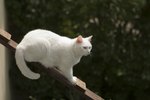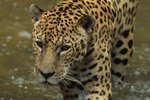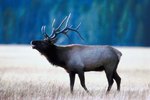
When it comes to finding a jaguar, a footprint might be all you see. Jaguars excel at staying out of sight and often live in remote areas. The big cat's name comes from 'yaguara,' a word for a beast that kills in one bound. Conservationists and researchers have used jaguar footprints to count and study jaguars. Footprint size helps to identify individuals, but it isn't an exact science.
Pugmark Research
The jaguar (Panthera onca) is a member of the panthera family. They once lived in the western United States but now are primarily found in South and Central America. A few jaguars remain in Mexico and southern Arizona, according to the ARKive website. Males weigh 119 to 348 pounds while females are smaller weighing in at 79 to 187 pounds. Scientists once used the shape and size of jaguar footprints, known as pugmarks, to distinguish individual cats. The method was problematic because the type of soil or sand affects the pugmarks, and the cat's rate of movement has an impact on the prints as well.
Print Characteristics
Like a domestic cat's foot, the jaguar's has a large pad with toes fanning out. One toe tends to be a bit forward of the others. The pad has a rough 'M' shape with slight peaks behind the toes and a wide base. The toes are tapered and make four oval-shaped imprints. Making a plaster cast of a big cat's print preserves detail. A cast of a jaguar's footprint works well to show the size of the animal's paw and how to identify its tracks for a classroom or nature presentation.
Print Measurements
A footprint from a jaguar's forefoot measures 4 inches long and 4.8 inches wide, Carlos López González reports on the Scholastic Explorer website. González, a wildlife biologist, studies big cats and other carnivorous animals at Chamela-Cuixmala Biosphere Reserve in Mexico. The researchers count and measure prints at specific locations, and keep records of the number and size of the tracks.
Cool Details
The jaguar walks with her claws retracted, so you won't see the cat's claws in her footprints. A jaguar's footprint is much larger than a puma or ocelot print and the toes have more space in between. Jaguars crouch out of sight and bound on their prey. The big cat crushes the skulls of animals it kills. These crushed skulls make an animal's corpse identifiable as a jaguar kill. Researchers now use automatic cameras to discern and study individual jaguars to help with population counting, according to the Wildlife Conservation Society website.
References
Resources
Photo Credits
-
Jupiterimages/Photos.com/Getty Images
Writer Bio
Gryphon Adams began publishing in 1985. He contributed to the "San Francisco Chronicle" and "Dark Voices." Adams writes about a variety of topics, including teaching, floral design, landscaping and home furnishings. Adams is a certified health educator and a massage practitioner. He received his Master of Fine Arts at San Francisco State University.




